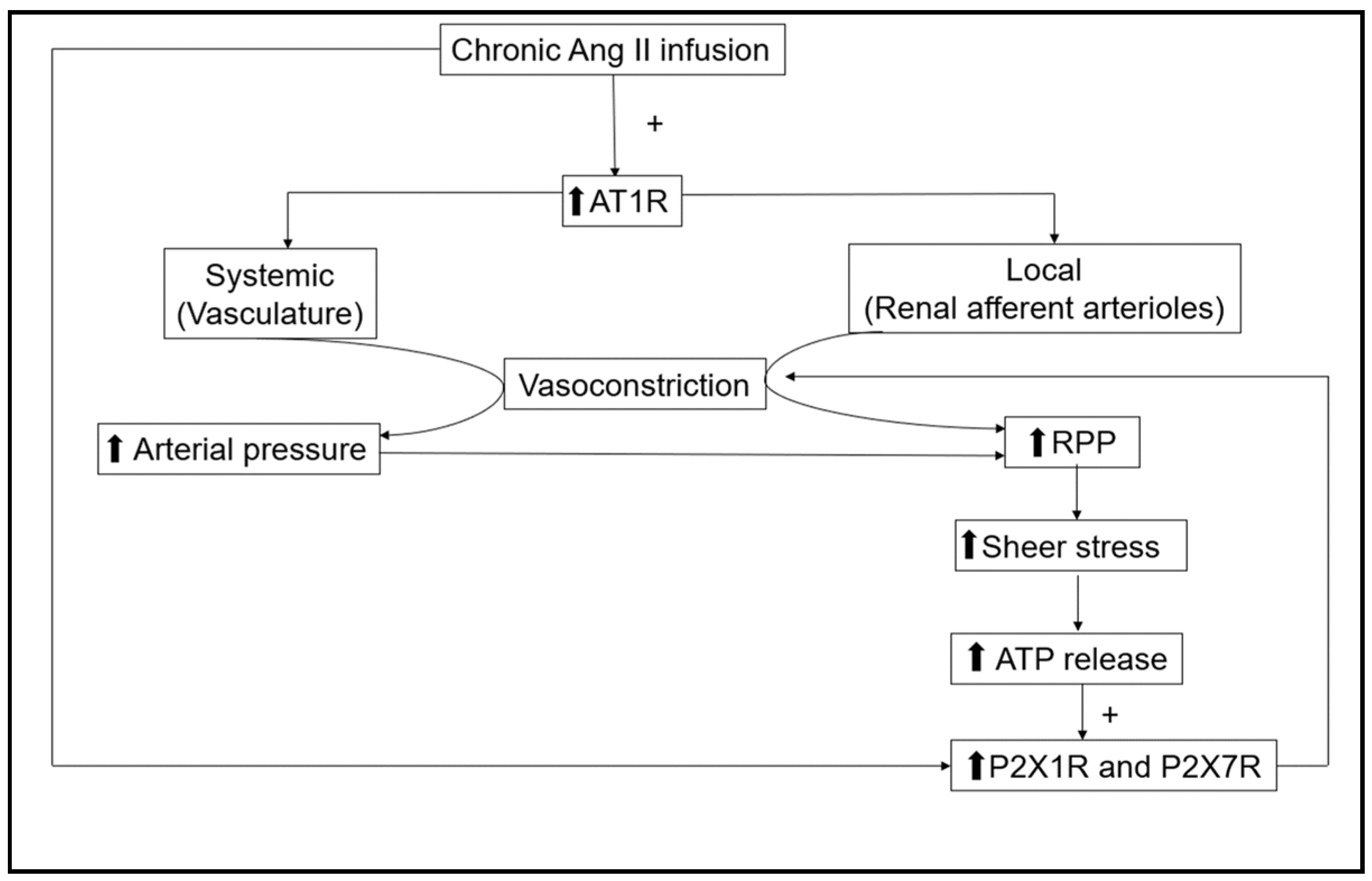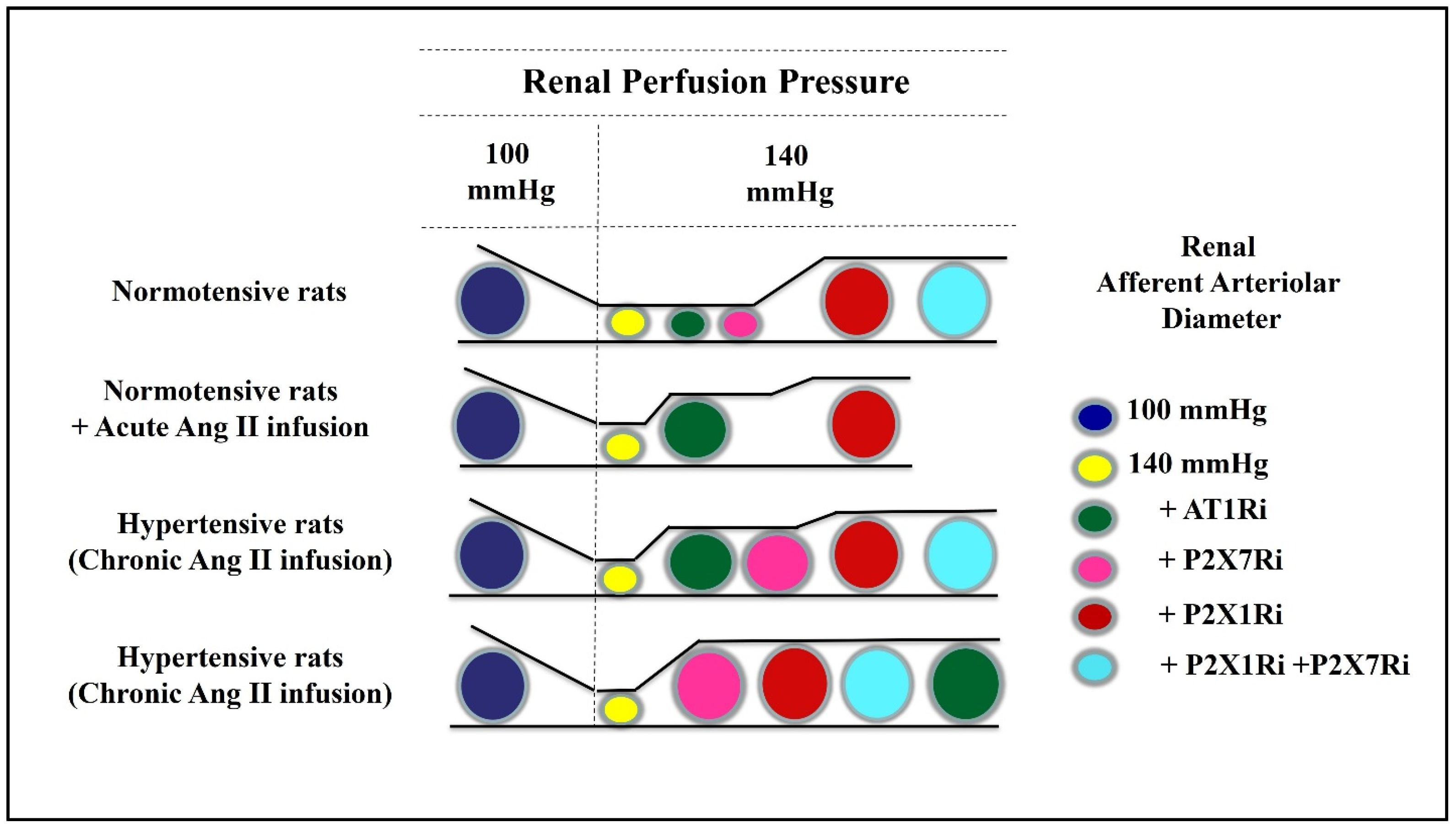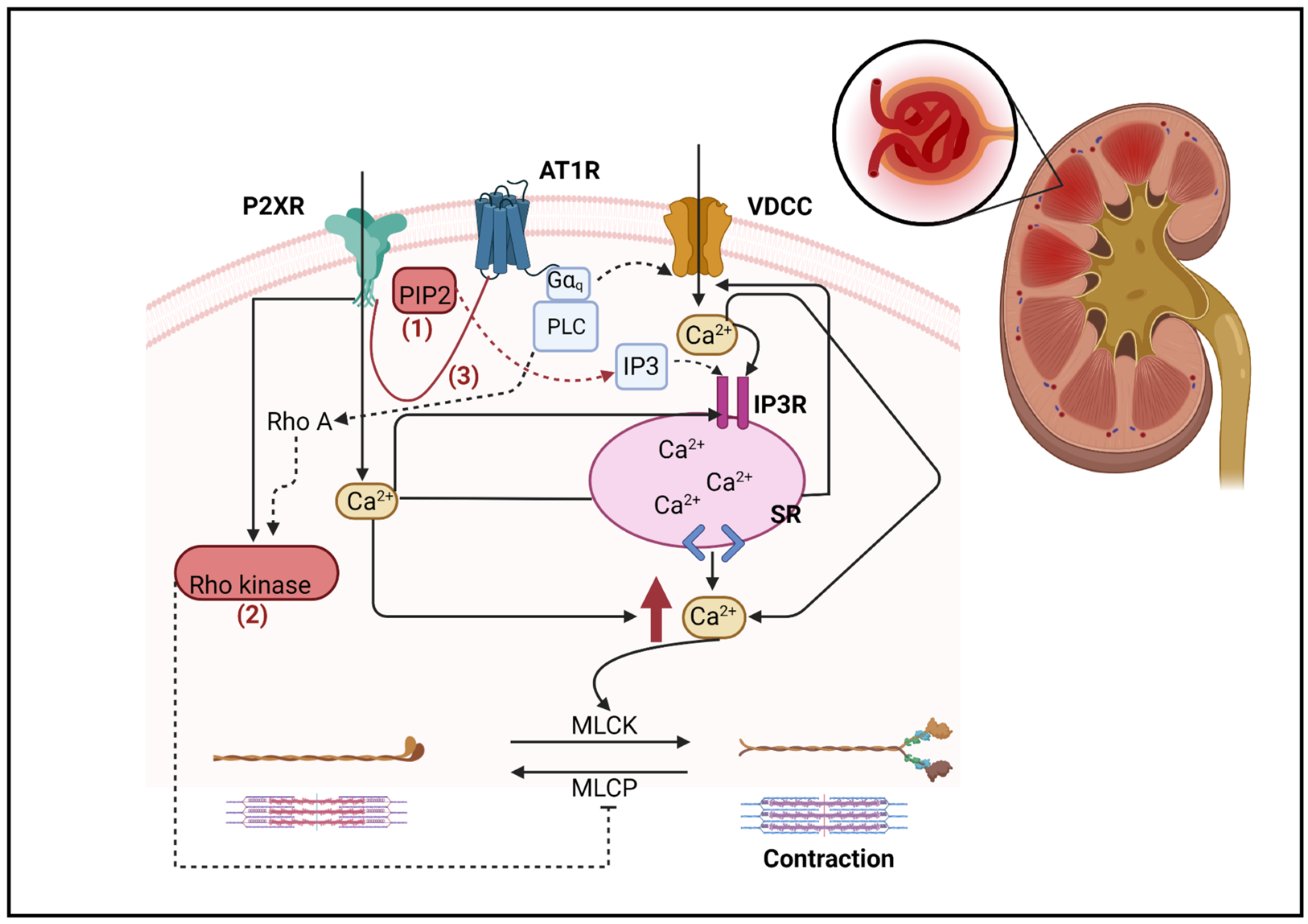Interaction of Angiotensin II AT1 Receptors with Purinergic P2X Receptors in Regulating Renal Afferent Arterioles in Angiotensin II-Dependent Hypertension
Abstract
1. Introduction
2. Regulation of Renal Afferent Arterioles in Ang II-Dependent Hypertension
3. Functional Evidence of AT1R and P2XR Interactions in Regulating Renal Afferent Arterioles
4. Mechanisms Regulating ATP Release and Effect of Angiotensin II on ATP Release
5. Intracellular Pathways Mediating Interactions between AT1 and P2X Receptors
6. The Involvement of NLRP3 Inflammasome in Angiotensin II-Dependent Hypertension
7. Conclusions
Author Contributions
Funding
Institutional Review Board Statement
Informed Consent Statement
Data Availability Statement
Conflicts of Interest
References
- Harrison-Bernard, L.M.; Navar, L.G.; Ho, M.M.; Vinson, G.P.; el-Dahr, S.S. Immunohistochemical localization of ANG II AT1 receptor in adult rat kidney using a monoclonal antibody. Am. J. Physiol. 1997, 273, F170–F177. [Google Scholar] [CrossRef]
- Miyata, N.; Park, F.; Li, X.F.; Cowley, A.W., Jr. Distribution of angiotensin AT1 and AT2 receptor subtypes in the rat kidney. Am. J. Physiol. 1999, 277, F437–F446. [Google Scholar] [CrossRef]
- Wang, Z.Q.; Millatt, L.J.; Heiderstadt, N.T.; Siragy, H.M.; Johns, R.A.; Carey, R.M. Differential regulation of renal angiotensin subtype AT1A and AT2 receptor protein in rats with angiotensin-dependent hypertension. Hypertension 1999, 33, 96–101. [Google Scholar] [CrossRef]
- Kasper, S.O.; Basso, N.; Kurnjek, M.L.; Paglia, N.; Ferrario, C.M.; Ferder, L.F.; Diz, D.I. Divergent regulation of circulating and intrarenal renin-angiotensin systems in response to long-term blockade. Am. J. Nephrol. 2005, 25, 335–341. [Google Scholar] [CrossRef]
- Nagai, Y.; Yao, L.; Kobori, H.; Miyata, K.; Ozawa, Y.; Miyatake, A.; Yukimura, T.; Shokoji, T.; Kimura, S.; Kiyomoto, H.; et al. Temporary angiotensin II blockade at the prediabetic stage attenuates the development of renal injury in type 2 diabetic rats. J. Am. Soc. Nephrol. 2005, 16, 703–711. [Google Scholar] [CrossRef]
- Navar, L.G.; Harrison-Bernard, L.M.; Imig, J.D.; Cervenka, L.; Mitchell, K.D. Renal responses to AT1 receptor blockade. Am. J. Hypertens. 2000, 13, 45s–54s. [Google Scholar] [CrossRef]
- Eguchi, S.; Kawai, T.; Scalia, R.; Rizzo, V. Understanding Angiotensin II Type 1 Receptor Signaling in Vascular Pathophysiology. Hypertension 2018, 71, 804–810. [Google Scholar] [CrossRef]
- Guan, Z.; Inscho, E.W. Role of adenosine 5′-triphosphate in regulating renal microvascular function and in hypertension. Hypertension 2011, 58, 333–340. [Google Scholar] [CrossRef] [PubMed]
- Menzies, R.I.; Tam, F.W.; Unwin, R.J.; Bailey, M.A. Purinergic signaling in kidney disease. Kidney Int. 2017, 91, 315–323. [Google Scholar] [CrossRef] [PubMed]
- Nishiyama, A.; Navar, L.G. ATP mediates tubuloglomerular feedback. Am. J. Physiol. Regul. Integr. Comp. Physiol. 2002, 283, R273–R275; discussion R278–R279. [Google Scholar] [CrossRef] [PubMed]
- Nishiyama, A.; Jackson, K.E.; Majid, D.S.; Rahman, M.; Navar, L.G. Renal interstitial fluid ATP responses to arterial pressure and tubuloglomerular feedback activation during calcium channel blockade. Am. J. Physiol. Heart Circ. Physiol. 2006, 290, H772–H777. [Google Scholar] [CrossRef] [PubMed]
- Zhang, Y.; Sands, J.M.; Kohan, D.E.; Nelson, R.D.; Martin, C.F.; Carlson, N.G.; Kamerath, C.D.; Ge, Y.; Klein, J.D.; Kishore, B.K. Potential role of purinergic signaling in urinary concentration in inner medulla: Insights from P2Y2 receptor gene knockout mice. Am. J. Physiol. Ren. Physiol. 2008, 295, F1715–F1724. [Google Scholar] [CrossRef]
- Franco, M.; Bautista, R.; Tapia, E.; Soto, V.; Santamaria, J.; Osorio, H.; Pacheco, U.; Sanchez-Lozada, L.G.; Kobori, H.; Navar, L.G. Contribution of renal purinergic receptors to renal vasoconstriction in angiotensin II-induced hypertensive rats. Am. J. Physiol. Ren. Physiol. 2011, 300, F1301–F1309. [Google Scholar] [CrossRef] [PubMed]
- Inscho, E.W.; Carmines, P.K.; Navar, L.G. Juxtamedullary afferent arteriolar responses to P1 and P2 purinergic stimulation. Hypertension 1991, 17, 1033–1037. [Google Scholar] [CrossRef]
- Inscho, E.W.; Cook, A.K.; Clarke, A.; Zhang, S.; Guan, Z. P2X1 receptor-mediated vasoconstriction of afferent arterioles in angiotensin II-infused hypertensive rats fed a high-salt diet. Hypertension 2011, 57, 780–787. [Google Scholar] [CrossRef] [PubMed]
- Menzies, R.I.; Unwin, R.J.; Bailey, M.A. Renal P2 receptors and hypertension. Acta Physiol. 2015, 213, 232–241. [Google Scholar] [CrossRef]
- Menzies, R.I.; Howarth, A.R.; Unwin, R.J.; Tam, F.W.; Mullins, J.J.; Bailey, M.A. Inhibition of the purinergic P2X7 receptor improves renal perfusion in angiotensin-II-infused rats. Kidney Int. 2015, 88, 1079–1087. [Google Scholar] [CrossRef]
- Franco, M.; Bautista-Perez, R.; Cano-Martinez, A.; Pacheco, U.; Santamaria, J.; Del Valle Mondragon, L.; Perez-Mendez, O.; Navar, L.G. Physiopathological implications of P2X1 and P2X7 receptors in regulation of glomerular hemodynamics in angiotensin II-induced hypertension. Am. J. Physiol. Ren. Physiol. 2017, 313, F9–F19. [Google Scholar] [CrossRef]
- Hayashi, K.; Epstein, M.; Saruta, T. Altered myogenic responsiveness of the renal microvasculature in experimental hypertension. J. Hypertens. 1996, 14, 1387–1401. [Google Scholar] [CrossRef]
- Navar, L.G.; Maddox, M.D.; Munger, K.A. The Renal Circulations and Glomerular Filtration. In Brenner & Rector’s the Kidney; Yu, A.S.L., Chertow, G.M., Luyckx, V.A., Marsden, P.A., Skorecki, K., Taal, M.W., Eds.; Elsevier: Amsterdam, The Netherlands, 2020. [Google Scholar]
- Navar, L.G.; Kobori, H.; Prieto-Carrasquero, M. Intrarenal angiotensin II and hypertension. Curr. Hypertens. Rep. 2003, 5, 135–143. [Google Scholar] [CrossRef]
- Imig, J.D. Afferent arteriolar reactivity to angiotensin II is enhanced during the early phase of angiotensin II hypertension. Am. J. Hypertens. 2000, 13, 810–818. [Google Scholar] [CrossRef] [PubMed]
- Crowley, S.D.; Gurley, S.B.; Herrera, M.J.; Ruiz, P.; Griffiths, R.; Kumar, A.P.; Kim, H.S.; Smithies, O.; Le, T.H.; Coffman, T.M. Angiotensin II causes hypertension and cardiac hypertrophy through its receptors in the kidney. Proc. Natl. Acad. Sci. USA 2006, 103, 17985–17990. [Google Scholar] [CrossRef] [PubMed]
- Harrison-Bernard, L.M.; El-Dahr, S.S.; O’Leary, D.F.; Navar, L.G. Regulation of angiotensin II type 1 receptor mRNA and protein in angiotensin II-induced hypertension. Hypertension 1999, 33, 340–346. [Google Scholar] [CrossRef] [PubMed]
- Nishiyama, A.; Seth, D.M.; Navar, L.G. Angiotensin II type 1 receptor-mediated augmentation of renal interstitial fluid angiotensin II in angiotensin II-induced hypertension. J. Hypertens. 2003, 21, 1897–1903. [Google Scholar] [CrossRef]
- Zhuo, J.L.; Imig, J.D.; Hammond, T.G.; Orengo, S.; Benes, E.; Navar, L.G. Ang II accumulation in rat renal endosomes during Ang II-induced hypertension: Role of AT(1) receptor. Hypertension 2002, 39, 116–121. [Google Scholar] [CrossRef]
- Li, X.C.; Navar, L.G.; Shao, Y.; Zhuo, J.L. Genetic deletion of AT1a receptors attenuates intracellular accumulation of ANG II in the kidney of AT1a receptor-deficient mice. Am. J. Physiol. Ren. Physiol. 2007, 293, F586–F593. [Google Scholar] [CrossRef]
- Wang, C.T.; Navar, L.G.; Mitchell, K.D. Proximal tubular fluid angiotensin II levels in angiotensin II-induced hypertensive rats. J. Hypertens. 2003, 21, 353–360. [Google Scholar] [CrossRef]
- Wang, C.T.; Zou, L.X.; Navar, L.G. Renal responses to AT1 blockade in angiotensin II-induced hypertensive rats. J. Am. Soc. Nephrol. 1997, 8, 535–542. [Google Scholar] [CrossRef]
- Nishiyama, A.; Majid, D.S.; Taher, K.A.; Miyatake, A.; Navar, L.G. Relation between renal interstitial ATP concentrations and autoregulation-mediated changes in renal vascular resistance. Circ. Res. 2000, 86, 656–662. [Google Scholar] [CrossRef]
- Palygin, O.; Evans, L.C.; Cowley, A.W., Jr.; Staruschenko, A. Acute In Vivo Analysis of ATP Release in Rat Kidneys in Response to Changes of Renal Perfusion Pressure. J. Am. Heart Assoc. 2017, 6, e006658. [Google Scholar] [CrossRef]
- Yamamoto, K.; Imamura, H.; Ando, J. Shear stress augments mitochondrial ATP generation that triggers ATP release and Ca2+ signaling in vascular endothelial cells. Am. J. Physiol. Heart Circ. Physiol. 2018, 315, H1477–H1485. [Google Scholar] [CrossRef] [PubMed]
- Bell, P.D.; Lapointe, J.Y.; Sabirov, R.; Hayashi, S.; Peti-Peterdi, J.; Manabe, K.; Kovacs, G.; Okada, Y. Macula densa cell signaling involves ATP release through a maxi anion channel. Proc. Natl. Acad. Sci. USA 2003, 100, 4322–4327. [Google Scholar] [CrossRef] [PubMed]
- Burnstock, G.; Knight, G.E. Cellular distribution and functions of P2 receptor subtypes in different systems. Int. Rev. Cytol. 2004, 240, 31–304. [Google Scholar] [CrossRef] [PubMed]
- Inscho, E.W.; Cook, A.K.; Imig, J.D.; Vial, C.; Evans, R.J. Physiological role for P2X1 receptors in renal microvascular autoregulatory behavior. J. Clin. Investig. 2003, 112, 1895–1905. [Google Scholar] [CrossRef]
- Inscho, E.W.; Cook, A.K.; Imig, J.D.; Vial, C.; Evans, R.J. Renal autoregulation in P2X1 knockout mice. Acta Physiol. Scand. 2004, 181, 445–453. [Google Scholar] [CrossRef] [PubMed]
- Kulthinee, S.; Shao, W.; Franco, M.; Navar, L.G. Purinergic P2X1 receptor, purinergic P2X7 receptor, and angiotensin II type 1 receptor interactions in the regulation of renal afferent arterioles in angiotensin II-dependent hypertension. Am. J. Physiol. Ren. Physiol. 2020, 318, F1400–F1408. [Google Scholar] [CrossRef] [PubMed]
- Bautista-Perez, R.; Perez-Mendez, O.; Cano-Martinez, A.; Pacheco, U.; Santamaria, J.; Rodriguez-Iturbe, F.R.B.; Navar, L.G.; Franco, M. The Role of P2X7 Purinergic Receptors in the Renal Inflammation Associated with Angiotensin II-induced Hypertension. Int. J. Mol. Sci. 2020, 21, 4041. [Google Scholar] [CrossRef]
- Graciano, M.L.; Nishiyama, A.; Jackson, K.; Seth, D.M.; Ortiz, R.M.; Prieto-Carrasquero, M.C.; Kobori, H.; Navar, L.G. Purinergic receptors contribute to early mesangial cell transformation and renal vessel hypertrophy during angiotensin II-induced hypertension. Am. J. Physiol. Ren. Physiol. 2008, 294, F161–F169. [Google Scholar] [CrossRef]
- Palygin, O.; Levchenko, V.; Cowley, A.W.; Staruschenko, A. Abstract 418: Angiotensin II Evokes Acute ATP and H2O2 Release in the Kidney. Hypertension 2013, 62 (Suppl. S1), A418. [Google Scholar] [CrossRef]
- Palygin, O.; Levchenko, V.; Ilatovskaya, D.V.; Pavlov, T.S.; Ryan, R.P.; Cowley, A.W., Jr.; Staruschenko, A. Real-time electrochemical detection of ATP and H2O2 release in freshly isolated kidneys. Am. J. Physiol. Ren. Physiol. 2013, 305, F134–F141. [Google Scholar] [CrossRef]
- Katsuragi, T.; Tamesue, S.; Sato, C.; Sato, Y.; Furukawa, T. ATP release by angiotensin II from segments and cultured smooth muscle cells of guinea-pig taenia coil. Naunyn Schmiedeberg’s Arch. Pharmacol. 1996, 354, 796–799. [Google Scholar] [CrossRef] [PubMed]
- Katsuragi, T.; Sato, C.; Guangyuan, L.; Honda, K. Inositol(1,4,5)trisphosphate signal triggers a receptor-mediated ATP release. Biochem. Biophys. Res. Commun. 2002, 293, 686–690. [Google Scholar] [CrossRef] [PubMed]
- Lucero, C.M.; Prieto-Villalobos, J.; Marambio-Ruiz, L.; Balmazabal, J.; Alvear, T.F.; Vega, M.; Barra, P.; Retamal, M.A.; Orellana, J.A.; Gomez, G.I. Hypertensive Nephropathy: Unveiling the Possible Involvement of Hemichannels and Pannexons. Int. J. Mol. Sci. 2022, 23, 5936. [Google Scholar] [CrossRef] [PubMed]
- Gomez, G.I.; Fernandez, P.; Velarde, V.; Saez, J.C. Angiotensin II-Induced Mesangial Cell Damaged Is Preceded by Cell Membrane Permeabilization due to Upregulation of Non-Selective Channels. Int. J. Mol. Sci. 2018, 19, 957. [Google Scholar] [CrossRef] [PubMed]
- Forrester, S.J.; Booz, G.W.; Sigmund, C.D.; Coffman, T.M.; Kawai, T.; Rizzo, V.; Scalia, R.; Eguchi, S. Angiotensin II Signal Transduction: An Update on Mechanisms of Physiology and Pathophysiology. Physiol. Rev. 2018, 98, 1627–1738. [Google Scholar] [CrossRef]
- Egan, T.M.; Khakh, B.S. Contribution of calcium ions to P2X channel responses. J. Neurosci. 2004, 24, 3413–3420. [Google Scholar] [CrossRef]
- Erb, L.; Liao, Z.; Seye, C.I.; Weisman, G.A. P2 receptors: Intracellular signaling. Pflug. Arch. Eur. J. Physiol. 2006, 452, 552–562. [Google Scholar] [CrossRef]
- Bernier, L.P.; Ase, A.R.; Seguela, P. Post-translational regulation of P2X receptor channels: Modulation by phospholipids. Front. Cell. Neurosci. 2013, 7, 226. [Google Scholar] [CrossRef]
- Nelson, C.D.; Kovacs, J.J.; Nobles, K.N.; Whalen, E.J.; Lefkowitz, R.J. Beta-arrestin scaffolding of phosphatidylinositol 4-phosphate 5-kinase Ialpha promotes agonist-stimulated sequestration of the beta2-adrenergic receptor. J. Biol. Chem. 2008, 283, 21093–21101. [Google Scholar] [CrossRef]
- Feng, Y.H.; Wang, L.; Wang, Q.; Li, X.; Zeng, R.; Gorodeski, G.I. ATP stimulates GRK-3 phosphorylation and beta-arrestin-2-dependent internalization of P2X7 receptor. Am. J. Physiol. Cell Physiol. 2005, 288, C1342–C1356. [Google Scholar] [CrossRef]
- Tian, X.; Kang, D.S.; Benovic, J.L. beta-arrestins and G protein-coupled receptor trafficking. Handb. Exp. Pharmacol. 2014, 219, 173–186. [Google Scholar] [CrossRef] [PubMed]
- Zanaty, M.; Seara, F.A.C.; Nakagawa, P.; Deng, G.; Mathieu, N.M.; Balapattabi, K.; Karnik, S.S.; Grobe, J.L.; Sigmund, C.D. beta-Arrestin-Biased Agonist Targeting the Brain AT(1)R (Angiotensin II Type 1 Receptor) Increases Aversion to Saline and Lowers Blood Pressure in Deoxycorticosterone Acetate-Salt Hypertension. Hypertension 2021, 77, 420–431. [Google Scholar] [CrossRef] [PubMed]
- Mathieu, N.M.; Nakagawa, P.; Grobe, C.C.; Reho, J.J.; Brozoski, D.T.; Lu, K.T.; Wackman, K.K.; Ritter, M.L.; Segar, J.L.; Grobe, J.L.; et al. ARRB2 (beta-Arrestin-2) Deficiency Alters Fluid Homeostasis and Blood Pressure Regulation. Hypertension 2022, 79, 2480–2492. [Google Scholar] [CrossRef] [PubMed]
- Zhu, X.; Jackson, E.K. RACK1 regulates angiotensin II-induced contractions of SHR preglomerular vascular smooth muscle cells. Am. J. Physiol. Ren. Physiol. 2017, 312, F565–F576. [Google Scholar] [CrossRef] [PubMed]
- Carrasquero, L.M.; Delicado, E.G.; Sanchez-Ruiloba, L.; Iglesias, T.; Miras-Portugal, M.T. Mechanisms of protein kinase D activation in response to P2Y(2) and P2X7 receptors in primary astrocytes. Glia 2010, 58, 984–995. [Google Scholar] [CrossRef]
- Nunes, K.P.; Rigsby, C.S.; Webb, R.C. RhoA/Rho-kinase and vascular diseases: What is the link? Cell. Mol. Life Sci. 2010, 67, 3823–3836. [Google Scholar] [CrossRef]
- Miyata, K.; Satou, R.; Shao, W.; Prieto, M.C.; Urushihara, M.; Kobori, H.; Navar, L.G. ROCK/NF-kappaB axis-dependent augmentation of angiotensinogen by angiotensin II in primary-cultured preglomerular vascular smooth muscle cells. Am. J. Physiol. Ren. Physiol. 2014, 306, F608–F618. [Google Scholar] [CrossRef]
- Navar, L.G. Intrarenal renin-angiotensin system in regulation of glomerular function. Curr. Opin. Nephrol. Hypertens. 2014, 23, 38–45. [Google Scholar] [CrossRef]
- Inscho, E.W.; Cook, A.K.; Webb, R.C.; Jin, L.M. Rho-kinase inhibition reduces pressure-mediated autoregulatory adjustments in afferent arteriolar diameter. Am. J. Physiol. Ren. Physiol. 2009, 296, F590–F597. [Google Scholar] [CrossRef]
- Guidolin, D.; Marcoli, M.; Tortorella, C.; Maura, G.; Agnati, L.F. Receptor-Receptor Interactions as a Widespread Phenomenon: Novel Targets for Drug Development? Front. Endocrinol. 2019, 10, 53. [Google Scholar] [CrossRef]
- Fellner, S.K.; Arendshorst, W.J. Angiotensin II-stimulated Ca2+ entry mechanisms in afferent arterioles: Role of transient receptor potential canonical channels and reverse Na+/Ca2+ exchange. Am. J. Physiol. Ren. Physiol. 2008, 294, F212–F219. [Google Scholar] [CrossRef] [PubMed]
- Mogi, M.; Iwai, M.; Horiuchi, M. New insights into the regulation of angiotensin receptors. Curr. Opin. Nephrol. Hypertens. 2009, 18, 138–143. [Google Scholar] [CrossRef] [PubMed]
- Rozenfeld, R.; Gupta, A.; Gagnidze, K.; Lim, M.P.; Gomes, I.; Lee-Ramos, D.; Nieto, N.; Devi, L.A. AT1R-CB(1)R heteromerization reveals a new mechanism for the pathogenic properties of angiotensin II. EMBO J. 2011, 30, 2350–2363. [Google Scholar] [CrossRef] [PubMed]
- AbdAlla, S.; Abdel-Baset, A.; Lother, H.; el Massiery, A.; Quitterer, U. Mesangial AT1/B2 receptor heterodimers contribute to angiotensin II hyperresponsiveness in experimental hypertension. J. Mol. Neurosci. 2005, 26, 185–192. [Google Scholar] [CrossRef] [PubMed]
- Barki-Harrington, L.; Luttrell, L.M.; Rockman, H.A. Dual inhibition of beta-adrenergic and angiotensin II receptors by a single antagonist: A functional role for receptor-receptor interaction in vivo. Circulation 2003, 108, 1611–1618. [Google Scholar] [CrossRef]
- Bellot, M.; Galandrin, S.; Boularan, C.; Matthies, H.J.; Despas, F.; Denis, C.; Javitch, J.; Mazeres, S.; Sanni, S.J.; Pons, V.; et al. Dual agonist occupancy of AT1-R-alpha2C-AR heterodimers results in atypical Gs-PKA signaling. Nat. Chem. Biol. 2015, 11, 271–279. [Google Scholar] [CrossRef]
- Nishimura, A.; Sunggip, C.; Tozaki-Saitoh, H.; Shimauchi, T.; Numaga-Tomita, T.; Hirano, K.; Ide, T.; Boeynaems, J.M.; Kurose, H.; Tsuda, M.; et al. Purinergic P2Y6 receptors heterodimerize with angiotensin AT1 receptors to promote angiotensin II-induced hypertension. Sci. Signal. 2016, 9, ra7. [Google Scholar] [CrossRef]
- Schroder, K.; Tschopp, J. The inflammasomes. Cell 2010, 140, 821–832. [Google Scholar] [CrossRef]
- Mariathasan, S.; Newton, K.; Monack, D.M.; Vucic, D.; French, D.M.; Lee, W.P.; Roose-Girma, M.; Erickson, S.; Dixit, V.M. Differential activation of the inflammasome by caspase-1 adaptors ASC and Ipaf. Nature 2004, 430, 213–218. [Google Scholar] [CrossRef]
- Satou, R.; Franco, M.; Dugas, C.M.; Katsurada, A.; Navar, L.G. Immunosuppression by Mycophenolate Mofetil Mitigates Intrarenal Angiotensinogen Augmentation in Angiotensin II-Dependent Hypertension. Int. J. Mol. Sci. 2022, 23, 7680. [Google Scholar] [CrossRef]
- Xia, M.; Abais, J.M.; Koka, S.; Meng, N.; Gehr, T.W.; Boini, K.M.; Li, P.L. Characterization and Activation of NLRP3 Inflammasomes in the Renal Medulla in Mice. Kidney Blood Press. Res. 2016, 41, 208–221. [Google Scholar] [CrossRef] [PubMed]
- Paik, S.; Kim, J.K.; Silwal, P.; Sasakawa, C.; Jo, E.K. An update on the regulatory mechanisms of NLRP3 inflammasome activation. Cell. Mol. Immunol. 2021, 18, 1141–1160. [Google Scholar] [CrossRef]
- Di Virgilio, F. Liaisons dangereuses: P2X(7) and the inflammasome. Trends Pharmacol. Sci. 2007, 28, 465–472. [Google Scholar] [CrossRef] [PubMed]
- Franceschini, A.; Capece, M.; Chiozzi, P.; Falzoni, S.; Sanz, J.M.; Sarti, A.C.; Bonora, M.; Pinton, P.; Di Virgilio, F. The P2X7 receptor directly interacts with the NLRP3 inflammasome scaffold protein. FASEB J. 2015, 29, 2450–2461. [Google Scholar] [CrossRef]
- Franco, M.; Martinez, F.; Rodriguez-Iturbe, B.; Johnson, R.J.; Santamaria, J.; Montoya, A.; Nepomuceno, T.; Bautista, R.; Tapia, E.; Herrera-Acosta, J. Angiotensin II, interstitial inflammation, and the pathogenesis of salt-sensitive hypertension. Am. J. Physiol. Ren. Physiol. 2006, 291, F1281–F1287. [Google Scholar] [CrossRef] [PubMed]
- Franco, M.; Perez-Mendez, O.; Kulthinee, S.; Navar, L.G. Integration of purinergic and angiotensin II receptor function in renal vascular responses and renal injury in angiotensin II-dependent hypertension. Purinergic Signal. 2019, 15, 277–285. [Google Scholar] [CrossRef]
- Krishnan, S.M.; Ling, Y.H.; Huuskes, B.M.; Ferens, D.M.; Saini, N.; Chan, C.T.; Diep, H.; Kett, M.M.; Samuel, C.S.; Kemp-Harper, B.K.; et al. Pharmacological inhibition of the NLRP3 inflammasome reduces blood pressure, renal damage, and dysfunction in salt-sensitive hypertension. Cardiovasc. Res. 2019, 115, 776–787. [Google Scholar] [CrossRef]



Disclaimer/Publisher’s Note: The statements, opinions and data contained in all publications are solely those of the individual author(s) and contributor(s) and not of MDPI and/or the editor(s). MDPI and/or the editor(s) disclaim responsibility for any injury to people or property resulting from any ideas, methods, instructions or products referred to in the content. |
© 2023 by the authors. Licensee MDPI, Basel, Switzerland. This article is an open access article distributed under the terms and conditions of the Creative Commons Attribution (CC BY) license (https://creativecommons.org/licenses/by/4.0/).
Share and Cite
Kulthinee, S.; Tasanarong, A.; Franco, M.; Navar, L.G. Interaction of Angiotensin II AT1 Receptors with Purinergic P2X Receptors in Regulating Renal Afferent Arterioles in Angiotensin II-Dependent Hypertension. Int. J. Mol. Sci. 2023, 24, 11413. https://doi.org/10.3390/ijms241411413
Kulthinee S, Tasanarong A, Franco M, Navar LG. Interaction of Angiotensin II AT1 Receptors with Purinergic P2X Receptors in Regulating Renal Afferent Arterioles in Angiotensin II-Dependent Hypertension. International Journal of Molecular Sciences. 2023; 24(14):11413. https://doi.org/10.3390/ijms241411413
Chicago/Turabian StyleKulthinee, Supaporn, Adis Tasanarong, Martha Franco, and Luis Gabriel Navar. 2023. "Interaction of Angiotensin II AT1 Receptors with Purinergic P2X Receptors in Regulating Renal Afferent Arterioles in Angiotensin II-Dependent Hypertension" International Journal of Molecular Sciences 24, no. 14: 11413. https://doi.org/10.3390/ijms241411413
APA StyleKulthinee, S., Tasanarong, A., Franco, M., & Navar, L. G. (2023). Interaction of Angiotensin II AT1 Receptors with Purinergic P2X Receptors in Regulating Renal Afferent Arterioles in Angiotensin II-Dependent Hypertension. International Journal of Molecular Sciences, 24(14), 11413. https://doi.org/10.3390/ijms241411413





